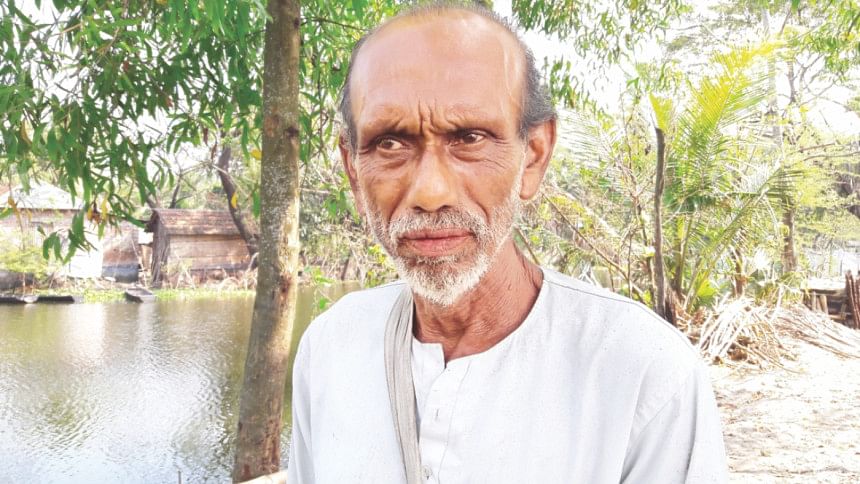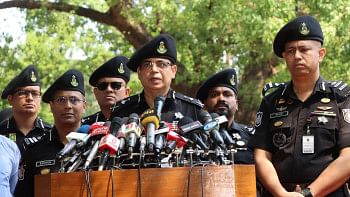SORROW OF JESSORE: Lasting for decades, getting graver every year

Bhabadah, often called the “Sorrow of Jessore”, where water is a symbol of suffering, hunger, disease, and death. The perennial waterlogging triggered from Bhabadah point affects mainly three upazilas -- Abhaynagar, Manirampur and Keshabpur -- home to some 10 lakh people. This year, almost six lakh inhabitants were affected when the flood situation was at its worst during the rainy season. Five months later, things have improved but many farmers won't still be able to grow crops. But what's the cause of Bhabadah's woes? Is there no solution? There is. Why is it not happening then? In this two-part story, WASIM BIN HABIB and TUHIN SHUBHRA ADHIKARY chronicle Bhabadah's saga at a time when, with much of the vast land still under this year's floodwaters, many beel people are wondering how they will prepare for the next rain.
On a pale October afternoon, Hari Chand Mandal was gazing at Beel Bokor, one of the 27 major beels in Bhabadah. As he sat on the bank of the vast, black wetland, a soft autumn breeze made ripples on its surface.
But Hari, 40, showed no interest in the wavelets. He had another, more pressing thought.
"I won't be able to grow Boro paddy on my land this year for sure," said the marginal farmer from Mashiahati Uttar Para of Abhaynagar in Jessore.
Farmers in other parts of the country have already started cultivating Boro rice, but those in Abhaynagar, Manirampur and Keshabpur upazilas see a grim prospect. Five months after the rainy season ended in July, some of their croplands still remain submerged by knee to waist-deep waters.

Just two months ago, Hari's life was full of miseries. With his elderly parents, wife and college-going son, he took shelter in a hut he built on a road, after the entire village went under waist-high waters following a heavy rain in mid-August (424mm or about 17 inches of rain in just three days -- August 10, 11 and 20).
Until mid-October, hundreds of families, including his, lived in such shacks and ate whatever food they had managed to store during dry season. The floodwaters now have receded from most homesteads, but not from their farmlands.
"If the water stays a few more months, we will have to go unfed,” Hari told The Daily Star in late October.
BHABADAH'S PLIGHT
His anxiety is shared by thousands of families in the three upazilas known as Bhabadah area, between Jessore and Khulna in southern Bangladesh. The area is crisscrossed by seven main rivers -- the Mukteshwari, Teka, Hari, Sree, Aparbhadra, Harihar and Buribhadra -- and many canals.
Aptly called the “Sorrow of Jessore,” much of Bhabadah remains inundated for months during rain almost every year.
This year, about 600,000 people in 286 villages have been affected in various degrees, according to Bangladesh Water Development Board (BWDB) officials in Jessore.

With all the rivers and canals silted up over the last three decades, the rain waters have nowhere to go now. So they get trapped in these beels, submerging homesteads, farmlands, roads and educational institutions.
When the waterlogging is at its worst, normal life comes to a standstill in these beels spreading over 487 square kilometres. There is hardly any work. Living space becomes so scarce that sometimes a whole family shares a single room with their cattle. Others sell out their domestic animals at nominal prices. Water gets contaminated, causing various skin and water-borne diseases. Fishes die.
Sometimes water snakes, frogs and other poisonous bugs, looking for a dry place, enter their huts, creating panic.
This year, at least 11 people, mostly children, drowned or died from snake bites, media reports said citing government officials.
Angered and shocked, hundreds of Bhabadah people travelled to Noapara, some 10km away, on October 5 to take to the streets, demanding government action. They were met with police action instead, in which some 50 people, including women and elderly campaigners, were injured.
Bhabadah's waterlogging problem began in the early 1980s when all its rivers started drying up, after the construction of costal embankments and sluice gates in the region. The embankments and sluice gates were built to prevent saline water from intruding into the beels. The saline water stopped, and so did the natural flow of currents in the process.

Successive governments have taken up various projects worth hundreds of crores of taka to solve this, but they only brought brief relief. Many of the projects were faulty. But more than that, every time the government initiated any projects, powerful locals blocked those to protect their interests, including the multi-million dollar shrimp farms.
NO PLACE TO BURY THE DEAD
This year, the problem turned acute. In the last three years, nothing was done to keep the rivers navigable. So when the entire area went under water, the BWDB installed an excavator to flush out waters by making a channel on the Hari river on August 30. It was too little too late.
Before this temporary measure could have an impact, some 73,400 hectres of land went under water. As a result, all of Bhabadah's 15,000 hectres of Aus and Aman farmland were damaged and some 300 schools and colleges had to stop educational activities for about a month, officials said.
Last month, local MP Shawpan Bhattacharjee estimated farmers won't be able to grow crops on half their land this Boro season.

Contacted on Sunday, Emdad Hossain Sheikh, deputy director of the Department of Agriculture Extension in Jessore, admitted some croplands were still under water. However, farmers would be able to cultivate their land by pumping out the water by shallow pumps.
But farmers and a local journalist who visited two beels on Sunday said that would be extremely difficult, even impossible, for many given the height of the water.
When The Daily Star visited the affected areas in Abhaynagar and Manirampur in late October, some families were still marooned in their shabby huts with waters all around. Many were still living on the roads while many others were repairing their badly damaged houses.
As floodwaters devoured her earthen house in Digholiya village in Abhaynaga's Paira union, Nurjahan, a 43-year-old widow, sent her grandchildren to her sister's in Noapara. Her two sons made a six by seven feet hut with bamboo and straw on a road. There, she lived with her sons and their wives for two months. She kept her cattle inside her hut.
“The life we lived was not at all a human life,” she said.
Drinking water was scarce; there were no proper toilets, only makeshift ones built on roads. Women used those mostly at night; many drank little water during day to avoid going to toilets. People struggled to take the sick to hospitals or bury their dead.
"There was water everywhere. We buried our sister-in-law in another village, three kilometres from ours," said Abdul Wahab Majumdar, also from Digholiya.
But those that still live are trapped; they have nowhere to go. Thousands, if not lakhs, of marginal farmers, day labourers, small vendors have had little income for the past four months. By now, they have run out of their savings and food stocks.
As they count their losses -- livelihoods, homes, loved ones -- floodwaters in some beels are showing little sign of receding from their farmlands, and it's not clear when they will be able to work again and start a normal life.

THE BEGINNING
Bhabadah's deep-seated waterlogging problem has its origin in the 1960s. The region had a different problem then. This low-lying area would be inundated during rain by the rising waters of the major rivers that crisscross this marshy land before falling into the Bay of Bengal about 60km to its south.
This extremely saline water posed a serious threat to crops, cattle, fish and human alike.
So the then Pakistan government took up a huge project funded by the Asian Development Bank and assisted by the USAID. Under this Coastal Embankment Project, around 1,500 kilometres of embankments, 282 sluice gates and some 35 polders were constructed along the rivers from 1961 to 1967. On the Sree river alone, a 21-vent sluice gate was built at Bhabadah point to turn the vast swamps into arable land.
Initially, the project was a hit; the area saw a bumper food production, said Jahangir Alam, member of the executive committee of Bangladesh Economic Association, who has been working on the waterlogging issue for years.
Farmers were so happy that they gave Abdul Monem Khan, the then governor of East Pakistan, a "gold scythe" as a gift, said Jahangir, who wrote a research paper on the problem and its solution.
But the whole project turned out to be a catastrophe within two decades.
Before the polders were built to trap the saline water, tides used to flow inland, depositing sediments at high tide, creating a balance with the natural land subsidence.
Polders (a Dutch word) are a low-lying tract of land enclosed by dikes that forms an artificial waterbody. They have no connections with outside water other than through manually operated devices.
However, after the construction of the embankments, sluice gates and polders, silt started to deposit on the riverbeds, while subsidence of the land within the polders continued. The natural process of land formation inside the polders came to a halt in the 1980s.
At the same time, currents in the upstream rivers -- mainly the Padma (Ganges in India) and its tributaries, particularly Bhairab which flows through Abhaynagar -- grew weak after India built the Farakka Embankment on the Ganges and started withdrawing water in the 1970s, said Prof M Shahjahan Mondal of the Institute of Water and Flood Management at the Buet.
In addition, the Coastal Embankment Project did not pay attention to silt management and so there was no long-term plan for river dredging in the area to clear the deposited silt. As a result, currents of these rivers lost force and the rivers started drying up and eventually the exit points of the sluice gates got blocked.
"In fact that [the embankment project] was the beginning of the ever-present calamity for the people, environment and nature," said Iqbal Kabir Jahid, chief adviser of Bhabadah Pani Nishkashon Sangram Committee, a platform campaigning for a solution for over a decade.

 For all latest news, follow The Daily Star's Google News channel.
For all latest news, follow The Daily Star's Google News channel. 



Comments